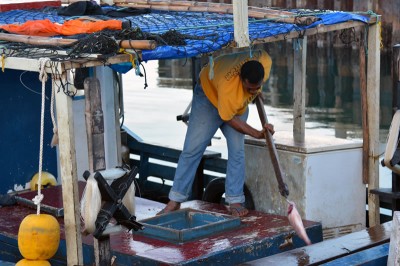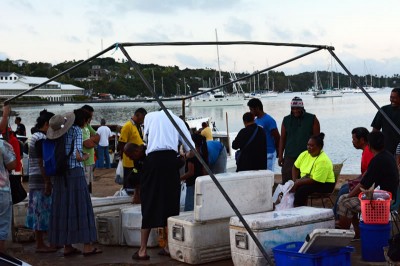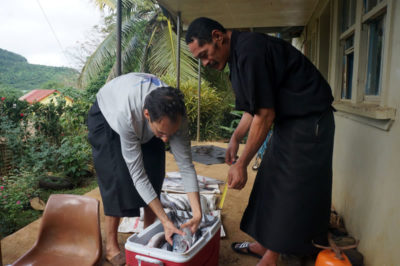It’s 6am in Neiafu, Vava’u. We’re driving down to the wharf in the dark because at first light, local community fishing boats return from an evening of hard work offshore. As another spectacular sunrise emerges from the low hills surrounding the Port of Refuge Harbor, fishers begin to unload their catch from their wooden hulled boats. These fishers have been out since yesterday, many of them snorkeling all night long with a light and simple spear; others have used baited lines to target their catch.

They are met by friends and family members who are busily setting up tables, chairs and a make-shift tarp tent, all of which they use to sell their catch to the local community. By morning’s first light, there was already a group of local residents patiently waiting to purchase fish. As customers neared the front of the line, they pointed out the fish they wanted, and the fish was bagged, weighed and then exchanged for cash. To our surprise, despite the vast variety of fish species sold, they all cost the same price, eight Pa’anga per kilogram (approx. US$4.30/kg). During the morning rush, snapper and emperors sold most quickly.

Each day, we came down to the market with the sunrise in order to interact with the fishers and learn more about Tongan fishing practices. One component of our work has been to identify and measure the fish catch that is sold at the market each morning. Another component has been to obtain quantitative information from the fishers about Tongan fishing practices, such as the gear they use, the species they target, and the habitats where they fish.

After the first few days at the fish markets, one of the things that we learned was that many fishers targeted a wide range of pelagic and reef fish species. After two weeks of observations, we identified 38 unique species being sold at the markets. The most common fish was the short-tailed red snapper, Etelis coruscans, which was present every day at the markets ranging in length from 45 to 80 cm. Grouper and emperors were prevalent. We also observed that there were a lot of herbivorous reef fish for sale in the market including surgeonfish, unicornfish and parrotfish.

Herbivorous reef fish are a culturally important part of Tongan diet, however, they also play an important role in maintaining the health of corals on the reef. As a result, it is important that fisheries, such as this one in Tonga, are properly managed to ensure that a balance exists between the use of these species for local human consumption as a source of protein, and the role these species play in sustaining coral reef health and resilience. Securing this balance for generations to come is the motivation behind the Living Oceans Foundation’s efforts in Tonga.
Photos by Stefan Andrews.